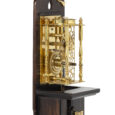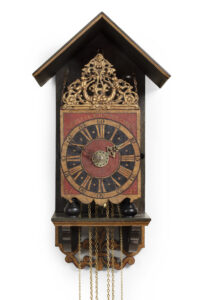JAPANSESE PILLAR CLOCK, ‘SHAKU-DOKEI’ WITH STRIKING Ca. 1820
M&R147
PILLAR CLOCK, ‘SHAKU-DOKEI’
WITH STRIKING
Circa 1820
Japan
Movement
The day-going, weight-driven movement is constructed between plates and has going and striking trains. The going train has verge escapement with balance on top of the brass clock case. It is driven by the striking movement which serves both as weight, hand bearer and striking. The skeletonised brass front is engraved with a chrysanthemum motif, where the clock is also wound. Top and bottom plates are connected by two turned pillars. The striking train is controlled by a countwheel and indicates the hours fully on a bell according to the Japanese system. After the going train is wound, the striking train can be wound through the hole at the top of the case, just under the movement.
Dial
The wooden dial has thirteen movable engraved brass hour chapters, called tokis. The Japanese characters on the tokis depict the following numbers from top to bottom: 6, 5, 4, 9, 8, 7, 6, 5, 4, 9, 8, 7, 6. The twelve brass buns between the hour chapters indicate the half hours. The time is indicated by a pierced and engraved brass pointer which slides down the case trunk, together with the striking mechanism. Next to the tokis, on the right-hand side, is a brass ruler which is of use when moving the tokis evenly to another position.
Case
The movement fits in a shitan (rosewood) case, the top glazed with lightwood inlaid piping on all sides so that the movement is entirely visible. Both sides of the trunk have large sound apertures with beautifully pierced brass frets. To wind the clock, the trunk cover can be slid up slightly, so that a drawer can be opened where the key is stored.
Duration 24 hours
Height 50 cm
Width 7.5 cm
Depth 7 cm
Literature
-W. Brandes, Alte Japanische Uhren, München, 1976
-N.H.N. Mody, Japanese Clocks, Rutland, 1977
-Tardy 3 parts, La Pendule Française JAPON, p.757-768
Note
Japanese time measurement is very different from its counterpart in the Western world. Instead of a fixed value for an hour the length of an hour in Japan, called toki is variable depending on the length of the day and night. Day and night are both divided into six toki, which lasts from sunrise to sunset and from sunset to sunrise. In summer the days are longer than the nights and consequently a day toki last longer than a night toki. In winter it is the other way around. This is the reason why Japanese clocks have sliding chapters to adjust the length of a toki. There are also clocks with a fixed chapter ring and a revolving hand. To regulate the lengths of the toki the weights on the foliot can be moved, which makes the clock go faster or slower. The hour numerals run from nine to four, the latter being midday. Japanese clocks indicate how many hours there are to come, whilst European clocks indicate how many hours have past. In Japan the figure 9 was holy. Each toki, twelve in total, also had its own sign of the zodiac, which were sometimes indicated on a ring around the chapter ring.
























